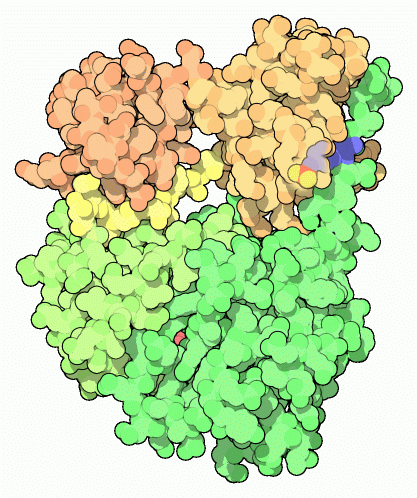|
Inhaltsübersicht | Nanomaschinen | Moleküle | Programme | Kurse | Fun | Links |
||
| > |
Src Tyrosine Kinase

Your body is a democratic nation of cells. Each cell is an individual with its own needs, but all of your cells work together to keep you alive. As you might imagine, this requires an incredible amount of cooperation. Cells are in constant communication to inform their neighbors of their needs and future plans. They send messages to each other, passing hormones and chemokines and other molecular messages from cell to cell. These messages are received by proteins in the cell membrane, which transmit the signal inside. There, a bewilderingly complex collection of proteins relays the message to all of the appropriate places inside the cell.
The Job of Src
The Src protein, shown here from PDB entry 2src, is a signaling protein that specializes in messages that control the growth of cells. It sits just inside the cell membrane, where it assists in the passing of signals from various protein receptors to the proteins that turn "on" the engines of protein synthesis and cellular growth. Src is a tyrosine kinase, so it relays its messages by adding phosphate groups to special tyrosine amino acids in protein chains. It adds phosphate groups to a wide variety of proteins that control cellular structure, cell communication, and cellular growth, turning them "on" and releasing them to perform their individual tasks.Redundancy
A lot of redundancy is built into this complex signaling system. Researchers have discovered hundreds of protein tyrosine kinases, several of which are nearly identical to Src. In fact, when researchers block the action of Src protein in laboratory animals, there is relatively no effect. Other similar proteins appear to be able to fill in for the lost function. A few similar proteins are available in the PDB, including the Hck protein, PDB entry 2hck, and the Abl protein, PDB entry 1opl. Normally, these proteins oversee a flurry of crossing messages, and we live, grow, and heal according to schedule. In many cases, loss of function has a relatively small effect, however, if the protein is made too active, the result is disaster.The src Oncogene
The DNA that encodes the Src protein is known as an oncogene, because it is a gene that is intimately connected with the development of cancer. The src oncogene was discovered because of this link with cancer: researchers found that the Rous sarcoma virus, which causes tumors in chickens, injects a protein similar to the normal form of Src, called v-Src (for "viral Src"). v-Src, in contrast to the cellular c-Src, is always active. It continually adds phosphate groups to the many proteins serviced by Src, sending a constant, unwavering signal to grow. This leads to cancer, as cells grow without control into tumors.Mutations in the normal form of Src, and mutations in other similar oncogene proteins, are often found in human cancers, if the mutations change the protein into a form that is continually active. Currently, researchers are looking for ways to stop these rogue kinases and restore the normal limits on growth. The drug Gleevec is a notable success. It blocks the action of the Abl protein, and is effective for the treatment of cancers where this protein is mutated.
Next: Many Moving Parts
Last changed by: A.Honegger,